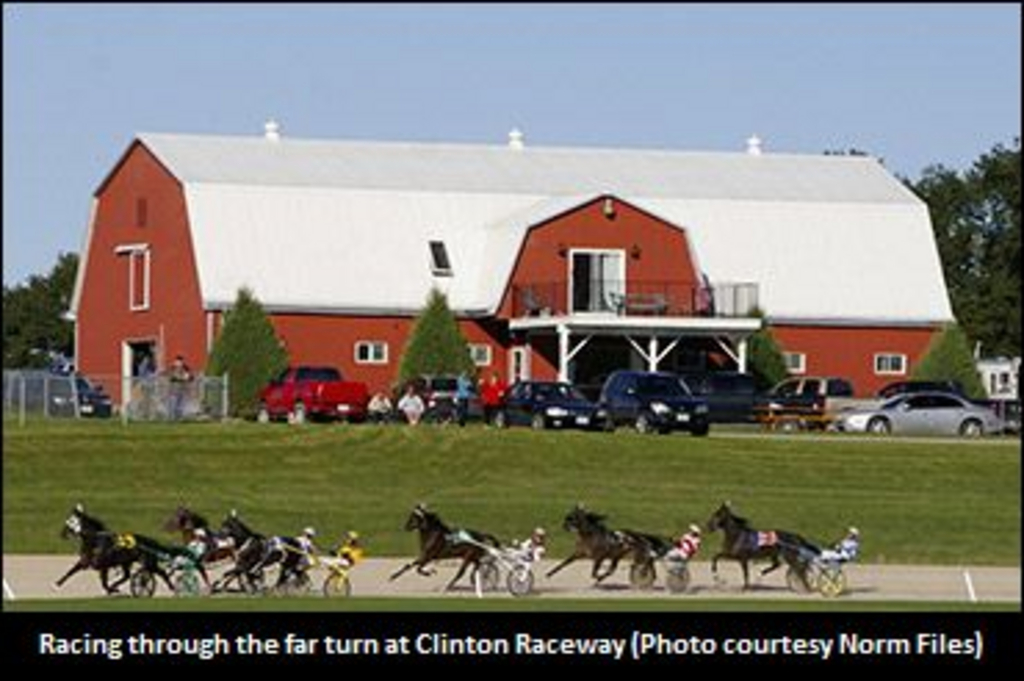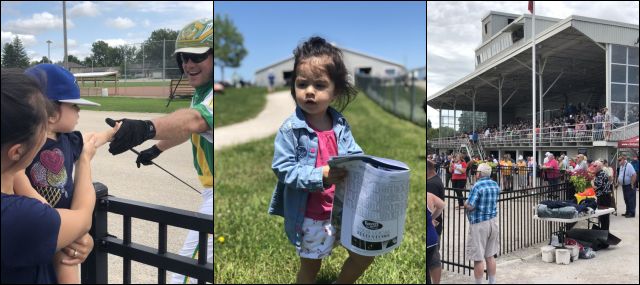
The United States Harness Writers Association has released its 'USHWA Youth Racetrack Review' for the month of October: 'Clinton Raceway: A Destination Racetrack for Ryan Clements and Family.' The item was written by Melissa Keith (with Ryan Clements), on behalf of the USHWA Youth Membership Committee.
The review appears below.
October USHWA Youth Racetrack Review
Clinton Raceway: A Destination Racetrack for Ryan Clements and Family
Although its 2020 season concluded on September 6, Clinton Raceway instantly comes to mind when Ryan Clements is asked about the most youth- and family-friendly tracks he's visited. Known for developing games like 'Off and Pacing,' 'Catch Driver,' and 'Top Jockey,' Clements is also a Standardbred owner/trainer who enjoys harness racing as a betting/spectator sport. Also, introducing his nearly-four-year-old daughter, Charlotte, to the game he loves is important to him.
And the ideal track for that is Clinton Raceway, an Ontario half-mile landmark that conducted its first extended pari-mutuel meet back in 1970. During this COVID-19-impacted year, Clinton was able to accommodate a limited number (100) of fans each race day, starting in July. The Huron County track still hit an all-time-high handle on closing day, as bettors sent $118,041 through the actual and virtual windows.
"I guess for me, the best time for family racing is summer, weekend, daytime racing," says a slightly-nostalgic Clements. "That's truly the best chance to get out as a family, because weeknights after school and after work, we're not going out to the track as a family. Maybe on a special occasion, once a year or something, but really, summertime weekends are when we plan it: 'Hey, let's drive out to Clinton and watch the races!'" Recalling previous years' visits to the small-town track, Clements describes what makes Clinton special: "I just love their environment. You can sit on the grass and pull out lawn chairs. It just makes for a great atmosphere with the young kids."
Hopefully 2021 will bring opportunities for Clements and family to get back to Clinton Raceway, alongside many others who share their high opinion of the venue. "It's a very casual experience," says the member of the US Harness Writers Association (USHWA) Youth Membership Committee. "We go there to spend the day, just being able to get the food from the food truck or whatever they've got there and enjoy the weather. For my daughter, she loves the horses, but they won't keep her attention all day. The fact that she can run around on the grass and play and have a fun day outside keeps her entertained. She'll see the horses a little bit, get a high-five from a driver, but it's a part of keeping her happy for the day."
Clements' photos from Clinton trips in 2017-2018 illustrate what makes the track a welcoming attraction for fans old and new. "As far as young kids go, one day we were there, [well-known harness racing artist] Michelle Hogan was there with her twins," he notes. "There's a lot of families in that situation, enjoying it. A lot of times, it's three generations: The grandparents are there in their lawn chairs, and everybody's just out for a casual day at the races."

Charlotte Clements, enjoying some time (pre-COVID-19) at Clinton Raceway (Photos courtesy Ryan Clements).
Charlotte shares her dad's enthusiasm: "She's always loved the horses. We were living on a horse farm when she was born, so we'd always walk out, see the horses, see the baby horses in the springtime. [...] When we go to the track, she's pretty happy to watch the horses run by."
Why bring children to the racetrack, when it's become a challenging or even forbidden practice at some, even pre-pandemic? Clements is clear: "I've always taken the stance that you can't introduce someone to horse racing through the gambling; they have to have an interest in the sport first. I think that's true whether people are betting on the NFL or any other sport; the interest in the sport comes first, or they'll end up betting on something they enjoy more. It's true of really any sport: You go to a hockey game, it's at a totally different level than experiencing it on TV. But our sport in particular, with these majestic animals... When you can stand right beside a 1,000-pound animal running down the stretch, and you can hear it and feel it, it really is totally different in real life than watching it on TV."
The technologically-minded horseman admits that accommodating youth in grandstands is "a difficult problem to solve" in fall and winter, when some of the sport's most family-/youth-oriented locations have concluded their annual meets, and those that remain open must designate some indoor space as off-limits to the under-19. "I don't think a lot of the tracks are trying to solve the problem right now. I don't think it's at the forefront of their minds," he observes, noting the reality that COVID-19-era restrictions mean limiting even the number of wagering-aged customers permitted indoors during colder months.
"I think that once we get back to some sense of normal, and you can be at the track and in the grandstand, it's just about making it somewhere that can be fun for families and can feel welcoming for them, not jammed in a corner, feeling like you're out of place there," continues Clements. "These kids, they don't want to be in the simulcast area. That's not going to appeal to them at all, so it definitely is harder when the weather gets bad, but [it's possible to make] it something fun, like the dining room giving them a place where they can actually enjoy it. We brought my daughter to the dining room at Mohawk and she really enjoyed watching the horses from up there."
He sees the business case for not excluding kids, or fans in general, from racetracks -- even racinos. "The primary purpose of casino companies is to run casinos, and they have to run racetracks in order to operate their casinos, so that's obviously going to be their focus," says Clements. "It's unfortunate the way that the situation is right now, we're sort of put at odds with each other rather than being able to help each other in a lot of different places. So it's definitely an unfortunate situation, and I don't think it's in anyone's best interest to be restricting who can be at the races. A lot of times it's not just the restriction, it's the fact that it becomes very clear whether kids are wanted there or not; whether or not they are banned is a different story, but you can tell when you're at a track that has no interest in having them. And it goes beyond kids. You can tell when you're at a track that has no interest in people being there to watch the races. You can tell by the way you are treated and what's available for you, if they want to make it compelling to bring people out or not."
Harness racing's most compelling places could be called 'destination' racetracks. Clements names another favourite that's well worth the drive: "Hanover [Raceway] in the summer, for example. Prior to COVID, they had plans this year for putting in a patio-level spot for young adults to go and have some beers and have live music. Tracks in Ontario can make a lot of revenue from casual racing fans." With colder weather settling in, tracks with ongoing race dates can still make their dining rooms as appealing, inclusive, and socially-distanced as possible to draw present-day revenue and create customers for the better years ahead. "I think there's opportunities all over in that area," he says, describing how a good grandstand restaurant can be a successful business- within-a-business. "People are looking for entertainment options right now, while they are limited, and I really thought that this was an opportunity, when [tracks] re-opened."
Do you know a harness track that's open to children and young adults attending live races in the late fall/winter, at least in a regular year? What are some of the ways it provides a comfortable and memorable afternoon or evening at the races? Please contact USHWA Youth Committee Chair Melissa Keith with your recommendations: [email protected].

